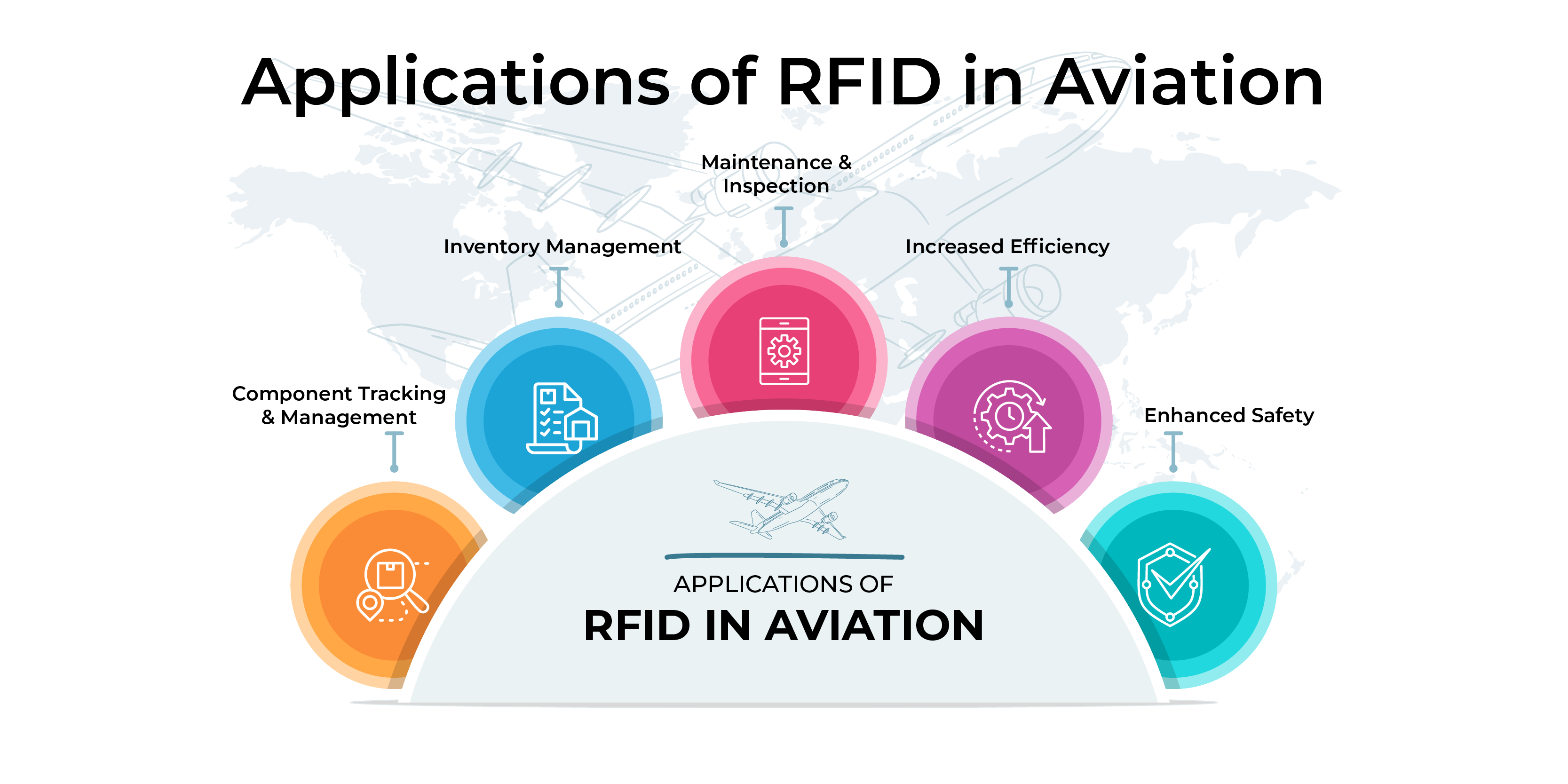Radio Frequency Identification (RFID) technology has significantly transformed numerous industries, including aviation, by providing a robust solution for enhancing operational efficiency, safety, and accuracy. In aviation, RFID is utilized to streamline various processes such as inventory management, baggage handling, and maintenance operations. By attaching RFID tags to aircraft components, tools, and baggage, airlines and maintenance crews can achieve real-time tracking and management, reducing the time spent on manual checks and minimizing errors. This blog explores the applications, benefits, and future potential of RFID in aviation and aircraft maintenance.
What is RFID?
Radio Frequency Identification (RFID) is a sophisticated technology that employs electromagnetic fields to automatically identify and track tags affixed to various objects. These tags contain electronically stored information that can be read from a distance, eliminating the need for direct line-of-sight scanning. The core components of an RFID system include tags, readers, and a database. Tags are embedded with microchips that store unique identification data and, in some cases, additional information about the object. Readers, equipped with antennas, emit radio waves to communicate with the tags, capturing the data stored within them. This data is then transmitted to a central database, where it can be processed, analyzed, and utilized for various applications. RFID technology is widely used across industries for inventory management, asset tracking, access control, and more, offering significant improvements in efficiency, accuracy, and automation.
Applications of RFID in Aviation

Component Tracking and Management
Aircraft Parts: Attaching RFID tags to aircraft components revolutionizes the way these parts are tracked and managed. Each RFID tag contains a unique identifier and can store additional information about the component, such as its maintenance history, installation date, and usage statistics. When these tagged components are integrated into an RFID system, maintenance crews can instantly locate any part using RFID readers, which scan the tags and retrieve the stored data. This real-time tracking capability significantly reduces the time and effort spent searching for parts, ensuring that maintenance activities are carried out more efficiently. Furthermore, the system can automatically update the central database with the latest status of each component, providing a comprehensive and up-to-date inventory.
Maintenance Tools: Implementing RFID technology for tracking maintenance tools significantly enhances the efficiency and reliability of aircraft maintenance operations. Each tool is equipped with an RFID tag that contains a unique identifier and relevant information, such as the tool’s usage history, calibration dates, and current status. When maintenance personnel need a specific tool, they can quickly locate it using RFID readers that scan the tags and provide real-time data on the tool’s location. This system ensures that tools are readily available when needed, minimizing delays in maintenance activities. Additionally, RFID tracking reduces the risk of tool loss or misplacement, as the system can alert staff if a tool is not returned to its designated storage area.
Inventory Management
Onboard Inventory: Airlines use RFID to manage onboard inventory, such as life vests, oxygen masks, and catering supplies. This ensures that all necessary items are present and in good condition before each flight.
Warehouse Management: RFID streamlines warehouse operations by providing accurate and real-time inventory data, reducing the chances of stockouts or overstocking.
Maintenance and Inspection
RFID technology plays a crucial role in enhancing the efficiency and accuracy of scheduled maintenance for aircraft. By attaching RFID tags to various aircraft parts, maintenance teams can store detailed maintenance histories and schedules. This information includes past maintenance activities, dates of service, and upcoming maintenance requirements. When a maintenance task is due, RFID readers can quickly scan the tags to retrieve this data, ensuring that all necessary maintenance activities are performed on time. This system not only helps in maintaining the aircraft’s operational reliability but also ensures compliance with regulatory standards by providing a clear and accessible record of all maintenance actions.
Increased Efficiency
RFID technology significantly enhances the efficiency of aircraft maintenance by reducing the time required to locate parts and tools. Each component and tool is tagged with an RFID chip that stores unique identification data. Maintenance personnel can use RFID readers to quickly scan and locate these items, eliminating the need for time-consuming manual searches. This streamlined process ensures that maintenance activities are carried out promptly, thereby minimizing aircraft downtime and improving overall operational efficiency. Additionally, RFID enables automated inventory management, which reduces the reliance on manual labor and minimizes the risk of human error. The system automatically updates inventory records in real time, providing accurate and up-to-date information on the availability and status of parts and tools.

Enhanced Safety
Accurate tracking of maintenance activities ensures that all components are properly maintained, reducing the risk of equipment failure and enhancing flight safety.
RFID helps in maintaining compliance with regulatory requirements by providing detailed records of maintenance activities.
Cost Savings
By improving inventory management and reducing the time spent on maintenance activities, RFID helps in lowering operational costs.
Reduced aircraft downtime translates to increased availability and revenue for airlines. Future Potential of RFID in Aviation
The future of RFID in aviation looks promising, with advancements in technology expected to further enhance its capabilities. Potential developments include:
Integration with IoT
Combining Radio Frequency Identification (RFID) with the Internet of Things (IoT) can significantly enhance the monitoring and maintenance of aircraft components. RFID tags, which are attached to various parts of the aircraft, continuously transmit data about their status and condition. When integrated with IoT systems, this data is collected and analyzed in real-time, providing a comprehensive overview of the aircraft’s health. This integration allows for predictive maintenance, where potential issues are identified and addressed before they lead to component failure or downtime.
Enhanced Data Analytics
Advanced data analytics can significantly enhance the value of the vast amounts of data collected through RFID systems. By applying sophisticated analytical techniques, such as machine learning and predictive modeling, organizations can uncover patterns and trends in maintenance data that were previously hidden. For instance, analytics can identify recurring issues with specific components, predict the lifespan of parts, and determine the optimal times for maintenance to prevent failures. This data-driven approach enables more informed decision-making, allowing maintenance teams to prioritize tasks based on the criticality and condition of components.
Environmental Factors
Tag Durability: RFID tags must be durable enough to withstand harsh environmental conditions, such as extreme temperatures and chemical exposure.
Interference: Electromagnetic interference from other devices can affect the performance of RFID systems. Proper planning and testing are required to mitigate these issues.
Case Studies and Success Stories
Delta Air Lines
Delta Air Lines has improved its maintenance operations by adopting RFID (Radio Frequency Identification) technology to track aircraft parts and maintenance tools. This system enables Delta to efficiently monitor and manage over 35,000 assets, including high-value and rotable parts, across its extensive network. By tagging and tracking these components, Delta can swiftly identify and replace expired or missing items, such as life vests and oxygen masks, which previously required time-consuming manual checks. The RFID system also optimizes inventory management, ensuring that necessary parts are always in stock and reducing the need for unscheduled maintenance. This proactive approach not only minimizes aircraft downtime but also enhances overall operational efficiency, bolstering Delta’s reputation for reliability and safety.
Conclusion
RFID technology continues to transform the aviation industry, offering numerous benefits in terms of efficiency, safety, and cost savings. As technology advances, the integration of RFID with other emerging technologies like IoT, blockchain, and AR will further enhance its capabilities. By embracing these innovations, the aviation industry can look forward to a future of improved operational excellence and safety.
